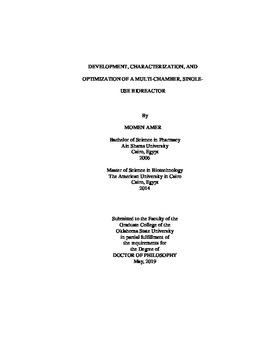| dc.contributor.advisor | Ramsey, Joshua D. | |
| dc.contributor.author | Amer, Momen | |
| dc.date.accessioned | 2019-10-25T19:02:54Z | |
| dc.date.available | 2019-10-25T19:02:54Z | |
| dc.date.issued | 2019-05-01 | |
| dc.identifier.uri | https://hdl.handle.net/11244/321522 | |
| dc.description.abstract | Stirred-tank single-use bioreactors have proven their capability to successfully replace their stainless-steel counterparts in the biopharmaceutical industry. To date, however, only a five-fold volume expansion is achievable in a single-use stirred tank bioreactor, which in turn necessitates intermediate equipment to scale-up the culture to production volume. This work introduces a novel multi-chamber single-use bioreactor design that can help users save costs of purchase and qualification of equipment, reduce factory footprint, and reduce the risk of contamination. A bioreactor prototype is presented in this work that is made of two chambers of different volumes, interconnected as a single, closed system. The design and construction of the prototype is described in detail, and engineering characterization results are reported for both chambers and compared with published data for commercially available bioreactors. The results help identify some areas of potential improvements in the bioreactor design. Optimization of a bioreactor design can be an especially challenging process and can lead to an exceedingly large number of configurations and necessary experiments. Therefore, a computational fluid dynamics model is used in this work to model the multiphase flow in the 50 L chamber of the multi-chamber bioreactor prototype. The model results are validated with oxygen mass transfer coefficient (kLa) measurements within the prototype. The validated model is projected to predict the effect of using different sparger types and sizes and the effect of varying the impeller diameter on kLa. The simulations show that ring spargers result in a superior kLa compared to pipe spargers, with an optimum sparger-to-impeller diameter ratio of 0.8. Also, larger impellers are shown to improve kLa. A correlation of kLa is presented as a function of both the reactor geometry and operating conditions. The resulting correlation can be used to predict kLa in a bioreactor and to optimize its design and operating parameters. Finally, a full commercialization plan for the multi-chamber bioreactor is presented. The plan proves that the proposed design not only offers a solution to a variety of industry problems but also presents an attractive investment opportunity to further develop the technology to a market ready product. | |
| dc.format | application/pdf | |
| dc.language | en_US | |
| dc.rights | Copyright is held by the author who has granted the Oklahoma State University Library the non-exclusive right to share this material in its institutional repository. Contact Digital Library Services at lib-dls@okstate.edu or 405-744-9161 for the permission policy on the use, reproduction or distribution of this material. | |
| dc.title | Development, Characterization, and Optimization of a Multi-Chamber, Single-Use Bioreactor | |
| dc.contributor.committeeMember | Gappa-Fahlenkamp, Heather | |
| dc.contributor.committeeMember | Ford Versypt, Ashlee N. | |
| dc.contributor.committeeMember | Smay, James E. | |
| osu.filename | Amer_okstate_0664D_16172.pdf | |
| osu.accesstype | Open Access | |
| dc.type.genre | Dissertation | |
| dc.type.material | Text | |
| dc.subject.keywords | bioreactor d design | |
| dc.subject.keywords | cfd | |
| dc.subject.keywords | population balance model | |
| dc.subject.keywords | single-use bioreactors | |
| dc.subject.keywords | stirred-tank reactors | |
| thesis.degree.discipline | Chemical Engineering | |
| thesis.degree.grantor | Oklahoma State University | |
